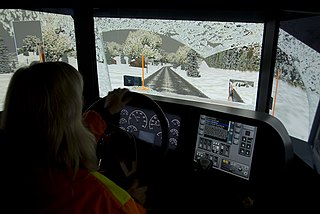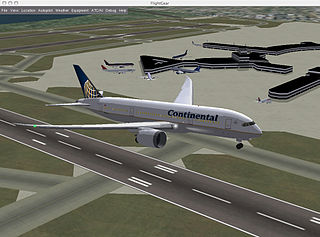Related Research Articles

A graphical user interface, or GUI, is a form of user interface that allows users to interact with electronic devices through graphical icons and audio indicators such as primary notation. In many applications, GUIs are used instead of text-based UIs, which are based on typed command labels or text navigation. GUIs were introduced in reaction to the perceived steep learning curve of command-line interfaces (CLIs), which require commands to be typed on a computer keyboard.

A flight simulator is a device that artificially re-creates aircraft flight and the environment in which it flies, for pilot training, design, or other purposes. It includes replicating the equations that govern how aircraft fly, how they react to applications of flight controls, the effects of other aircraft systems, and how the aircraft reacts to external factors such as air density, turbulence, wind shear, cloud, precipitation, etc. Flight simulation is used for a variety of reasons, including flight training, the design and development of the aircraft itself, and research into aircraft characteristics and control handling qualities.

A game controller, gaming controller, or simply controller, is an input device or input/output device used with video games or entertainment systems to provide input to a video game. Input devices that have been classified as game controllers include keyboards, mouses, gamepads, and joysticks, as well as special purpose devices, such as steering wheels for driving games and light guns for shooting games. Controllers designs have evolved to include directional pads, multiple buttons, analog sticks, joysticks, motion detection, touch screens and a plethora of other features.

Tactical shooter is a sub-genre of first- and third-person shooters, associated with using strategy, planning, and tactics in gameplay, as well as the realistic simulations of ballistics, accurate firearm mechanics, physics and stamina, and low time to kill. Dating back to the late 1980s, the genre first rose to prominence in the late 1990s with the releases of several well-received tactical shooters. The popularity of the genre saw a decline in the late 2000s as more the arcade-like fast-paced action of other types of shooters rose to prominence, but it has seen a revitalization since the mid-2010s with the successful releases of several modern tactical shooters.

Telerobotics is the area of robotics concerned with the control of semi-autonomous robots from a distance, chiefly using television, wireless networks or tethered connections. It is a combination of two major subfields, which are teleoperation and telepresence.
X-Plane is a flight simulation software initially launched by Laminar Research in 1995. Commercial desktop versions are sold for macOS, Windows, and Linux. In addition, Laminar Research also distributes FAA-certified versions for professional use. A mobile version has been available for Android, iOS, and webOS since 2009 as well.
An application program is a computer program designed to carry out a specific task other than one relating to the operation of the computer itself, typically to be used by end-users. Word processors, media players, and accounting software are examples. The collective noun "application software" refers to all applications collectively. The other principal classifications of software are system software, relating to the operation of the computer, and utility software ("utilities").

A simulation cockpit, simpit or sim rig is an environment designed to replicate a vehicle cockpit. Although many pits commonly designed around an aircraft cockpit, the term is equally valid for train, spacecraft or car projects.

A motion simulator or motion platform is a mechanism that creates the feelings of being in a real motion environment. In a simulator, the movement is synchronised with a visual display of the outside world (OTW) scene. Motion platforms can provide movement in all of the six degrees of freedom (DOF) that can be experienced by an object that is free to move, such as an aircraft or spacecraft:. These are the three rotational degrees of freedom and three translational or linear degrees of freedom.

A maritime simulator or ship simulator is a system that simulates ships and maritime environments for training, research and other purposes. Today, simulator training given by maritime schools and academies is part of the basic training of maritime professionals.

Immersion into virtual reality (VR) is a perception of being physically present in a non-physical world. The perception is created by surrounding the user of the VR system in images, sound or other stimuli that provide an engrossing total environment.
The Deployable Virtual Training Environment (DVTE) is a laptop based platform for a wide variety of training simulations in the USMC. TRASYS web. DVTE consists of two main components, the Combined Arms Network (CAN) and the Infantry Tool Kit (ITK). A typical DVTE suite consists of 32 laptops and a modified NVisor SX Head-mounted display (HMD).
An instructional simulation, also called an educational simulation, is a simulation of some type of reality but which also includes instructional elements that help a learner explore, navigate or obtain more information about that system or environment that cannot generally be acquired from mere experimentation. Instructional simulations are typically goal oriented and focus learners on specific facts, concepts, or applications of the system or environment. Today, most universities make lifelong learning possible by offering a virtual learning environment (VLE). Not only can users access learning at different times in their lives, but they can also immerse themselves in learning without physically moving to a learning facility, or interact face to face with an instructor in real time. Such VLEs vary widely in interactivity and scope. For example, there are virtual classes, virtual labs, virtual programs, virtual library, virtual training, etc. Researchers have classified VLE in 4 types:

In computing, an input device is a piece of equipment used to provide data and control signals to an information processing system, such as a computer or information appliance. Examples of input devices include keyboards, mouse, scanners, cameras, joysticks, and microphones.

A flight simulation video game refers to the simulation of various aspects of flight or the flight environment for purposes other than flight training or aircraft development. A significant community of simulation enthusiasts is supported by several commercial software packages, as well as commercial and homebuilt hardware. Open-source software that is used by the aerospace industry like FlightGear, whose flight dynamics engine (JSBSim) is used in a 2015 NASA benchmark to judge new simulation code to space industry standards, is also available for private use. A popular type of flight simulators video games are combat flight simulators, which simulate combat air operations from the pilot and crew's point of view. Combat flight simulation titles are more numerous than civilian flight simulators due to variety of subject matter available and market demand.

Simulator rides are a type of amusement park or fairground ride, where the audience is shown a movie while their seats move to correspond to the action on screen.
The DiSTI Corporation is a company that provides software tools for the development of GUI software and 3D virtual training for simulators and embedded systems.
The virtual world framework (VWF) is a means to connect robust 3D, immersive, entities with other entities, virtual worlds, content and users via web browsers. It provides the ability for client-server programs to be delivered in a lightweight manner via web browsers, and provides synchronization for multiple users to interact with common objects and environments. For example, using VWF, a developer can take video lesson plans, component objects and avatars and successfully insert them into an existing virtual or created landscape, interacting with the native objects and users via a VWF interface.
Military Open Simulator Enterprise Strategy (MOSES) is a U.S. Army project evaluating the ability of OpenSimulator to provide independent and secured access to a virtual world.

A full motion racing simulator, sometimes called a full motion sim rig, is a motion simulator that is purposed for racing, and must provide motion simulation in all six degrees of freedom, as defined by the aviation simulator industry many decades ago. The six degrees of freedom coincide with Earth physics, and are commonly referred to as:
References
- 1 2 3 4 5 6 7 8 9 10 11 12 13 14 15 16 17 18 Templeman, J.; Denbrook, P. (2012). "Enhancing Realism in Desktop Interfaces for Dismounted Infantry Simulation". Interservice/Industry Training, Simulation, and Education Conference (I/ITSEC).
- 1 2 3 4 5 6 7 8 9 10 11 12 13 14 15 16 17 18 Templeman, J.; Denbrook, P. (2012). "Pointman: a User Interface for Dismounted Infantry Simulation". Proceedings of the International Summit on Human Simulation: 95–105.
- 1 2 3 4 5 Templeman, J.N.; Sibert, L.E.; Page, R.C.; Denbrook, P.S. (2009). "Pointman Turning Virtual Reality into a More Realistic and Effective Infantry Training Ground". NRL Review: 60–65.
- 1 2 3 Templeman, J. "Enhancing Realism in Desktop Interfaces for Dismounted Infantry Simulation".
- 1 2 Biron, Lauren. "Pointman Adds Head, Leg Motion to PC Sim". Defense News. Archived from the original on May 8, 2014. Retrieved 2 January 2013.
- 1 2 3 4 5 6 Office of Naval Research, Code 30: Expeditionary Maneuver Warfare & Combating Terrorism Dept. (2012). "Pointman Dismounted Infantry Simulation Interface Military Utility Assessment Report".
{{cite journal}}: Cite journal requires|journal=(help)CS1 maint: numeric names: authors list (link) - ↑ Denbrook, P. (March 2014). "Quick Reference Cards". VBS-Pointman Training Package (Pointman Version 3.1.034).
- ↑ Denbrook, P. (March 2014). "Training Guide". VBS-Pointman Training Package (Pointman Version 3.1.034).
- ↑ "Marine Corps Vision & Strategy 2025". Office of Naval Research.